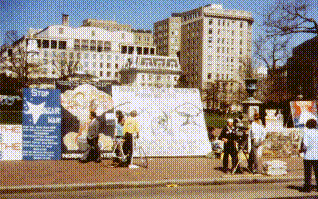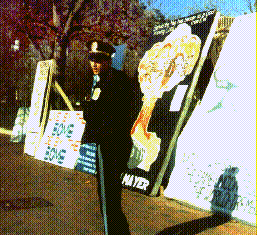 THE WASHINGTON TIMES
THE WASHINGTON TIMES
August 8,1984SIGNS TAKING ROOT IN LAFAYETTE PARK
By Charles E. Wheeler
The Washington Times
Dozens of large protest signs have gone up in Lafayette Park since last year's National Park Service regulations restricting demonstrations on the White House sidewalk, and they're getting mixed reviews from locals and tourists.
Many of the signs are almost the size of billboards and most have sturdy, semi-permanent support braces anchored in the park.
"They look horrible," a White House staffer said yesterday.
"My little nieces and nephews came to visit Washington and when they went back to upstate New York that's all they talked about," she said.
Here starts an anti-nuclear 24 hour vigil since June 1981 maintained by Thomas and Concepcion," says a narrow, hand- lettered sign.
More than 100 feet (and 18 signs) later, the row of protest signs erected by "Thomas and Concepcion" ends.
"There are no real restrictions on structures like there are on the sidewalk in front of the White House," said attorney Trish Bangert of the Interior Department, when asked about the size and semi-permanent status of some of the signs in Lafayette Park.
Restrictions apply only if a structure is attached to a tree or disrupts the environment in some other way, she said. All of the protest signs in Lafayette Park are free- standing.
Signs by Thomas and Concepcion account for more than half the total number now resting in Lafayette Park.
They aren't the only protesters, though. A new 12-foot by 12-foot sign was getting a final touch of paint Monday just a few yards from where Thomas and Concepcion have their display.
Most of the signs condemn nuclear war, but one 15-foot-long by 10-foot-high sign says, "God is the Absolute."
A smaller sign says: "Arrest me-I question the validity of the national debt."
The most imposing structure stands 16-feet high, is 12 feet wide and cries out in silver and black paint, "Have a nice Doomsday".
They don't bother me at all," said Sue Eubanks of Fredericksburg, Va. "They're better across the street [in Lafayette Park] so the president can look out the window and see them," she said.
"If they've got time to paint signs, they've got time to get a job and go to work," said as Indiana man who just arrived with his wife for their first visit to the nation's capital.
"That's how we got the money to come to Washington-work," he said.
The signs "should be there, of course," because "its a free country" said a man from New York City.
"Oh, my Lord! They're funny, though," he said.
"There ought to be a better way to do it than littering," said Mike Kuntz, a University of Nebraska student visiting from Lincoln.
"It's just a barrage of senseless words and graffiti across from the White House," said his friend, Joe Frazier, a University of Virginia student from McLean.
The Federal Court of Appeals held a formal hearing July 25 concerning the constitutionality of some of the Park Service regulations restricting signs on the sidewalk directly in front of the White House.
A decision is expected within a month or two, an Interior Department spokesman said.
Protesters maybe able to go back across the street the White House sidewalk if the court rescinds the Park Service regulations. If not, the protest signs in Lafayette Park may continue to grow in number and size.

Protesting According to the Rules
The Washington Post
Saturday, November 3, 1984 By Philip Smith
Washington Post Staff Writer
Daily, except for unwelcome trips to court or jail, Concepcion Picciotto has stood her White House vigil since the summer of 1981, protesting the spread of nuclear arms. In those three years, she has been arrested 15 times.
"I believe in the ideals of this country," Picciotto says in her native Spanish accent, vowing to stand fast: within eyeshot of the president of the United States across Pennsylvania Avenue.
She wears a wig the size of a football helmet and a chestful of buttons carrying political slogans. But Picciotto's legal difficulties are not rooted, at least directly, in anyone's suspicion that she is a wide-eyed, bomb-throwing radical.
Instead, Picciotto and other protesters have run afoul of a new thicket of regulations drawn up by the Interior Department, enforced by the U.S. Park Police and recently blessed by the courts, and designed to restrict those who choose the president's doorstep to express their political opinions..
The rules, in effect since May, are expected to get their first major test since winning court approval when demonstrators gather today for a rally called by the Community for Creative Non-Violence.
The regulations leave little to a demonstrator's imagination:
A demonstrator who is not carrying a placard or sign, for example, may sit to rest on the White House fence ledge. If he rests while holding a placard, he is subject to arrest.
Signs of up to 20 feet in length and three feet in height may be set up on portions of the White House sidewalk. All must be at least three feet from the fence to guard against concealed explosives.
Signs constructed of cardboard, posterboard or cloth may be carried by demonstrators. Wooden signs are forbidden because, security experts testified in court this year, they could be used to scale the White House fence.
In a central zone extending 10 yards on either side of the White House fence centerpost along Pennsylvania Avenue, stationary signs are prohibited in order to clear the view for tourists. Demonstrators may be in the "central zone" while carrying signs, if they keep moving.
In a series of recent court cases, federal officials have defended the rules as necessary to protect against acts of terrorism and preserve the beauty of the White House view.
Lawyers for the demonstrators, including the American Civil Liberties Union, continue to complain that the restrictions are illegal intrusions on First Amendment guarantees of free speech and the right to assemble.
With relatively little fanfare, the onset of the regulations-prompted, according to the administration, by the threat of a demonstrator to blow up the Washington Monument two years ago-has turned the White House sidewalk and Lafayette Park into a legal battleground.
"There is no more important place for demonstrators than out in front of the White House," says Jeffrey Pash, a lawyer at the prestigious law firm of Covington and Burling who has represented some indigent protesters in court.
"Whether the First Amendment has been backed into a corner, that might be a little strong. But the regulations are certainly a setback for people like Concepcion."
"Frankly we were shocked that we had so much trouble getting the rules through the courts," counters Royce C. Lamberth, chief of the U.S. Attorneys office civil division. "The White House is probably one of the most vulnerable living residences of a head of state in the world."
Interior spokeswoman Sandra Alley said Interior received numerous complaints from tourists before the department banished large, permanent protest signs from in front of the mansion to nearby Lafayette Park.
Administration officials say their concerns about presidential security were heightened considerably when, on Dec. 8,1982, a longtime White House protester,Norman Mayer, backed a truck up to the Washington Monument and threatened to detonate 1,000 pounds of dynamite. When Mayer tried to drive away, possibly headed for 1600 Pennsylvania Avenue,police shot him to death.
"One thing that was obvious," Lamberth said of the episode, "was, what do we do when the same thing happens at the White House?"
In the view of attorney Pash, security then became "an all purpose alibi" for a crackdown on demonstrators' activities near the White House. "Whether Mayer caused the new regulations or was more of an excuse is certainly open to question," he says.
As evidence of the administration's attitude, Pash cites a Jan. 13, 1983 MEMO by then-Interior Secretary James Watt. In the memo, included in a recent court case, Watt asked for a briefing on the demonstrators. "My intention is to prohibit such activities and require that they take place in the Ellipse," well south of the White House grounds, Watt said. His sweeping idea never took effect, but interior moved to implement its stricter regulations soon afterward.
Earlier this year, U.S. District Judge William B. Bryant threw out the rules, branding them "totally ineffective" and "demonstrably too vague." Bryant's ruling, however, was stayed by the U.S. Court of Appeals while the government's appeal was pending.
Last Friday, the U.S. Court of Appeals in White House Vigil for the ERA Committee v. William P. Clark, upheld the regulations for both security and esthetics reasons.
In the face of such pronouncements, Picciotto says she tries to toe the Interior Department's Line. "I just moved in here," she says, indicating a patch of sidewalk in Lafayette Park where demonstrators have been told to stand during the reseeding of the park lawns.
"I think I'm all-right here, but I'm not sure."
Camping or using park land for living accommodation purposes.
Attaching signs or other objects to lamp posts, trees or structures in the park.
Constructing, including painting, signs or structures in the park.
Storing construction materials-lumber paint, tools, laundry carts, luggage, household items,food or personal property-in the park.
Injuring federal property, including snow fencing, grass or other vegetation or structures.
Erecting structures without an official permit.
Using sound equipment so as to disturb nonparticipating persons in the area unreasonably.
Failing to hold or secure signs so as to eliminate safety hazards. Signs must be secured from high winds and supports must not pose a tripping or other hazard.
Failing to have dogs or cats entirely under control and caged or on a leash not more than six feet long.
NOTE: In order to reseed the park, public access to the grassy areas currently is being restricted. Until the grass is established, which is expected to take another two to four weeks, all activities, including demonstrations, have been relocated to the sidewalks within the park.
RULES FOR SIGNS ON SIDEWALK IN FRONT OF WHITE HOUSE
No signs or placards shall be permitted on the White House sidewalk except those made of cardboard, posterboard or cloth having dimensions no grater than three feet in width, 20 feet in length, and one quarter inch in thickness.
No supports shall be permitted for signs or placards except those made of wood having cross-sectional dimensions no greater than three quarters of an inch by three quarters of an inch.
Stationary signs or placards shall be no closer than three feet of the White House sidewalk fence.
All signs and placards shall be attended at all times they are on the White House sidewalk. Signs or placards shall be considered attended only when they are in physical contact with a person.
No signs or placards shall be tied, fastened, or otherwise attached to or leaned against the White House fence, lamp posts or other structures on the White House sidewalk.
No signs or placards shall be held, placed or set down on the center portion of the White House sidewalk, comprising 10 yards on either side of the center point on the sidewalk. However, individuals may demonstrate while carrying signs on that portion of the sidewalk if they continue to move along the sidewalk.


